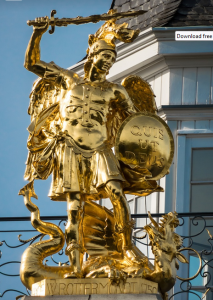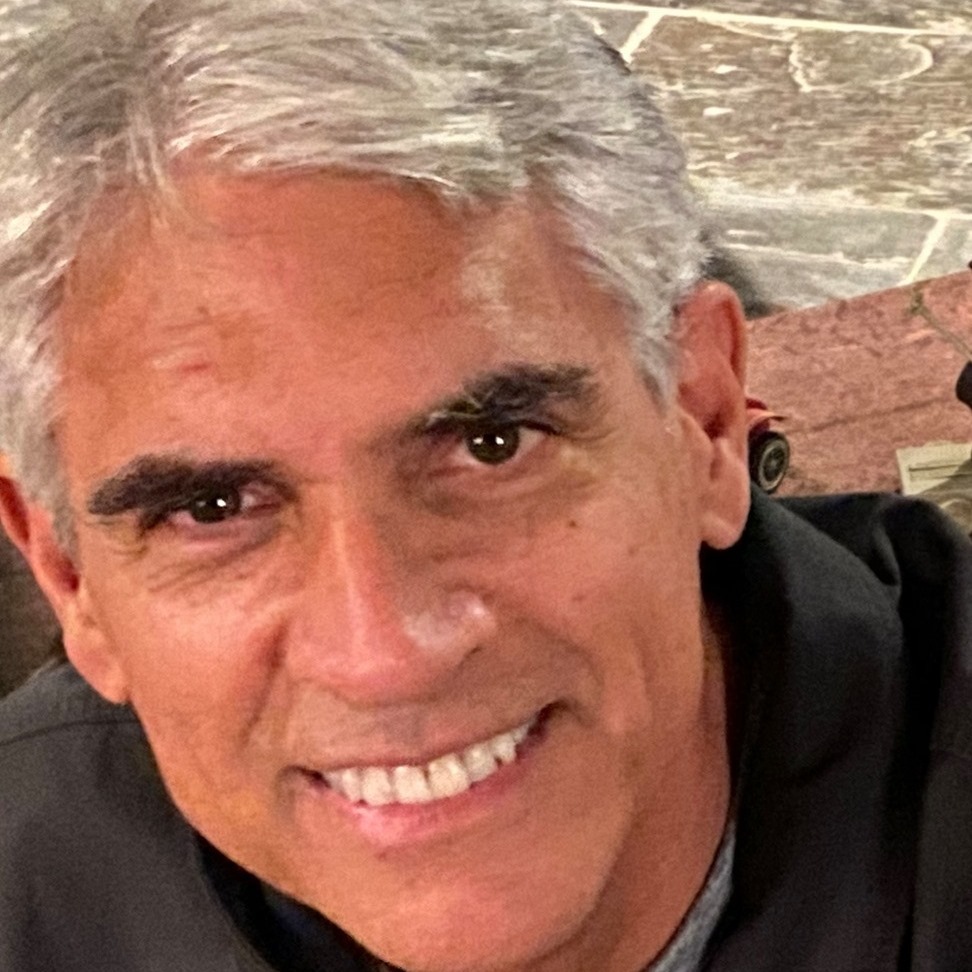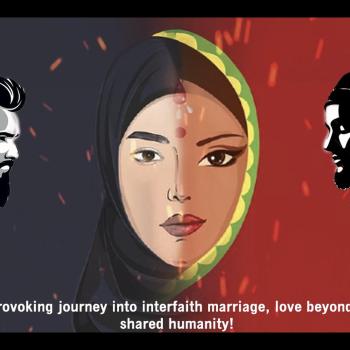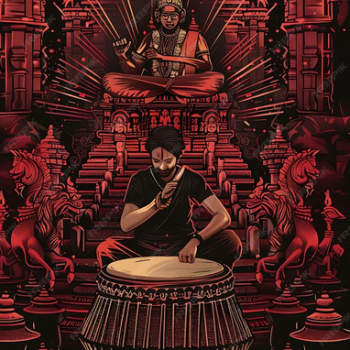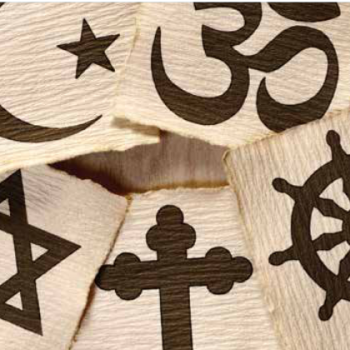It is important to explain just how this article came to be. Recently, I was approached by Hinduism Today Magazine. A writer had begun an essay on the similarity between the Judeo-Christian Archangel Michael and the Hindu god Murugan, but passed away before it was finished. She was hoping to have it published in the magazine. So because of my Roman Catholic background, I was asked to help finish it. I offered my thoughts, and the essay will be appearing in Hinduism Today quite soon. But I thought that this idea was worth expanding. So here is my humble offering. Please note that the majority of the research that was done by Gayantri Rajan. I submit this in honor of her brilliant spiritual curiosity and commitment to interfaith engagement.>
My Primary Encounters
Growing up in the Catholic school system in the United States in the 1960s, I was immersed in the culture of saint veneration. We were encouraged to pay special attention to our patron saint; the one for whom we were named in Baptism. But beyond that, if you were a girl you were expected to hold Virgin Mary in special esteem, as you would want to imitate many of her saintly feminine qualities.
The challenge with being a boy was that so many of the men canonized by the church were rather meek. They often gave themselves up as martyrs without struggle. Their pictures rarely inspired. This created a dichotomy for us. Outside of church and school we were exposed to superheroes, brave warriors and policemen. Meekness did not attract us easily. However, the nuns had a secret weapon underneath all of their cloaks: St. Michael the Archangel.
Before we go further, you should know what we mean by “saint.” According to Catholic tradition, a saint is someone who lived a flawed but model life. One must be dead to be canonized a saint. It is believed that the soul of the person is in Heaven and can intercede with lives on this side of the veil. However, using the title of saint in relation to Michael is more of an honorific, as it simply means “holy.” To be a true saint in the formal use of the word one must have existed as a human, belonged to the Catholic Church, lived as close to the ideal of Jesus as possible, and caused miracles such as divine healings to happen after death.
We loved Michael because he broke all the stereotypes of a saint. Always pictured with a sword (often flaming), Michael took on the baddest of the bad—Satan.
Moving in a Different Direction
By the time I was 15 I no longer held some of the most important dogmas of the Church and began seeking wisdom outside of its confines. This is what led me to the Dharma. While I never held the view that all religions are the same, when a similarity struck me I certainly couldn’t and can’t ignore it. A good example is the way Christians venerate angels and Hindus do the same with Devas and Devis, what are often referred to as “gods and goddesses.” For one example, let’s look at St. Michael and the Mahadeva Murugan, also known by several other names including Skanda and Kartikeya.
This Angel Gets Around
St. Michael appears in all three major Abrahamic religions, although he isn’t seen as a warrior in Islam. But in both Jewish and Christian scriptures he is indeed a force to be reckoned with.
The words archangel and mahadeva actually have the same meaning: The prefix Arch- is from the Greek and means “chief or principal,” “highest in rank or authority or office,” “to govern, rule” or “individuals…directing or having authority over others of their class.” Maha-, from the Sanskrit, means great, mighty, strong, very important; for example, Sri Mohandas Gandhi was called the “Mahatma”: maha: great, atma:soul. Mahadeva means a great, important or mighty deva, or a great, mighty shining being. They are called shining beings because they exist in bodies of light in the Sivaloka.
In the world of mythology there are certain archetypes that are universal. As much as religious and spiritual traditions affirm nonviolence and peaceful coexistence as a high (arguably the greatest) virtue, warriors are some of the highest profile entities who dominate the stories that create civilizations and societies. Hinduism has plenty of iconic figures, including Devas, Devis and historical persons who by example have shown that sometimes physical force is necessary to protect the Dharma.
Pacifist or Warrior Religion?
What is interesting about Christianity is that its first few centuries were replete with stories of nonviolent resistance to oppressive adversaries as adherents attempted to replicate the actions of their founder Jesus of Nazareth. It is possible to read the gospels of New Testament as a handbook for a pacifist lifestyle. Several Christian sects have done so. However, for those with a more martial temperament, there is always the Book of Revelation, which closes out the Christian Bible. Here we have the “lamb led to the slaughter,” as Jesus is portrayed in the gospels, return “with a vengeance,” so to speak. In this apocalyptic account, Jesus and his heavenly military forces battle the traitor-angel now known as Satan (or Lucifer)and banish to hell his minions and all those humans who sided with him. While more liberal Christian denominations downplay this, or dismiss it altogether, those who “sided with Satan” include all those who never acknowledged Jesus as Lord and Savior.
And who is aiding the Christ in this war at Armageddon? None other than St. Michael, the fire-sworded soldier angel for whom this moment he was created.
From the Jewish Canon
We are introduced to Michael in the Hebrew Bible, known to Christians as the Old Testament. Throughout the books in this collection of scriptures, we see the Jewish people constantly engaged in battles with various nemeses as they struggle to maintain their religion and freedom. In the Book of Daniel, Michael is defined as “the great prince who protects [the Jews]…”
It is prophesied that there “will be a time of distress such as has not happened from the beginning of nations until then. But at that time your people—everyone whose name is found written in the book—will be delivered.” (Daniel 12:1) It is clear from the context here and in other portions that Michael is no ordinary prince, nor is he human, but celestial.
We later meet up with Michael in the Christian New Testament. The only 2 books that mention him directly are Jude and Revelation. Most Christians pass over the former text and focus exclusively on those passages in the latter, as here we see him at his most fierce, accomplishing what he seems to be created for—defeating the rebellious Satan and his minions and banishing them from the kingdom of heaven at the beginning of time. Yet, Christians also see Michael in the Book of Daniel as an indication that he will be appearing on the scene at some point in the future. While both Jews and Christians share the Hebrew biblical books, they interpret them differently.
Christians tend to use the stories therein to point to the coming of Jesus as the messiah, both in his birth 2,000 years ago and his “Second Coming” when there will be the final battle of good and evil. In this conflict both Jesus and Michael lead an army of angels to establish the heavenly kingdom.
So, where are the similarities?
The aforementioned war in Heaven corresponds closely with the Hindu tradition’s Lord Skanda leading his army of devas to victory against the demon Surapadman and his platoon of iniquitous asuras (demonic spirits), who had embarked on a wild frenzy of devastation, wreaking havoc on the universe and terrorizing the devas.
Many believe these stories to be allegorical: the real battle is ongoing and takes place within each of us–not necessarily as dramatic as a cosmic war between good and evil, but the daily battle by striving souls to overcome the lower tendencies of anger, fear, laziness, etc., and to mobilize the will power needed to progress on the spiritual path. Lord Skanda presides over the manipura chakra, the chakra of will power.
We find numerous other parallels between these majestic beings: the color associated with each is red, both are associated with the element of fire–although in the case of Lord Skanda, it is not so much physical fire as it is the kundalini fire. The element of fire brings light that illuminates darkness and heat to stimulate the will to prevail.
And Those Weapons?
Both bear weapons–in the case of Michael (who often is pictured wearing armor or chain mail), his sword, and for Skanda a lance, called the Vel. It is understood by Hindus, though, that the Vel is a weapon of grace, destroying ignorance and illusion, and its sharp point gives us discrimination–viveka. This perception is also held of Michael by some, although as far as I know, his sword does not come into play in this context. It will always be true of weapons and other implements in the hands of a Hindu deity that they are figurative rather than literal, as all deities are absolutely benign, even the ferocious-seeming Kali.
Both Michael and Skanda are fiery, forceful, and exceedingly dynamic; charismatic and resplendently beautiful (one of the names for Lord Skanda in the Tamil language of South India is Alahan, the beautiful.) Beyond the Bible, legends about Michael abound. He is described in one source as “young, strong and handsome; very huge and militant; eyes looking like pools of fire with firm, chiseled facial features. Supposedly, angels are sexless, but clearly, it’s easy to find artistic renditions of Michael as not only male, but quite the hottie. His skin was described as the “color of copper which radiates and glows from being in the Presence of God.” Remarkably, this is exactly the concept of Lord Kartikkeya; one of his names is “Ceyon,” meaning the “coppery red one.”
Beyond War
In addition to being a warrior, Murugan presides over the heads of nations and helps to guide them on a dharmic path; he is the god of religion, fostering all religions in all parts of the world; he is the lord of yoga and renunciation, to whom serious aspirants on the spiritual path supplicate for success. Murugan has a vahana (vehicle), his mount, is the peacock, symbolizing his conquest of vanity and pride. Skanda as Shanmuga, or Arumugam, has 6 faces, symbolizing his origin in the Pleiades, as well as the fact that he sees everything in all directions, and has 6 main functions, or qualities. St. Michael is thought of as a healer by some. Lord Murugan is a healing mahadeva as well.
There is a temple in southern India dedicated to Him as Lord Palani, the renunciate, to which many people go for healing. The icon there is made of nine special minerals, poisonous in their natural state, which become medicinal when water is poured over them, which happens during the ceremonies conducted there. This water is then passed out to the devotees and is considered an efficacious medicine.
And just as Michael is considered the guardian of the Jewish people, Lord Murugan is the overseer of the ancient Dravidian Tamil people of South India. He is known as the god of the Tamils and is said to have given them the beautiful Tamil language.
Bless Me, Michael, For I Have…
St. Michael is thought to be the angel of repentance, righteousness, mercy and sanctification. Although many Mahadevas in the Hindu pantheon could be considered to fulfill this function, for Saivites, it would be Lord Skanda to whom they would turn in moments of contrition, confusion or darkness.
A more controversial concept of Archangel Michael is that he is identical with Jesus–that he is the son of God. This notion is considered heresy by the vast majority of Christians. The denominations that hold this view are not considered truly Christian by most others. The name Michael means “who is like God.” Yet, it does bring up another interesting similarity: Hindus think of Lord Skanda as one of the sons of Shiva, the other son being Ganesha. The idea of sons of God in this case though, is not literal, implying physicality, but a way of emphasizing the importance and preeminence of these mahadevas in the Saiva pantheon and understanding their proximity to the Supreme, having been created as mahadevas rather than souls subject to reincarnation.
Jews also call Michael Metatron. Though not indicated in the Bible, the Talmud refers to Metatron/Michael as the “Staff of God,” which is in harmony with the vel of Skanda and Michael’s sword.
Wrapping This Up
If one reads the works of great mythologists like Joseph Campbell one cannot help but see how the human consciousness, always striving to transcend the mundane, draws from the deep well of imagery that tends to show us that while not exactly the same, we often express the same needs and desires as we seek to explain our mortal condition.


